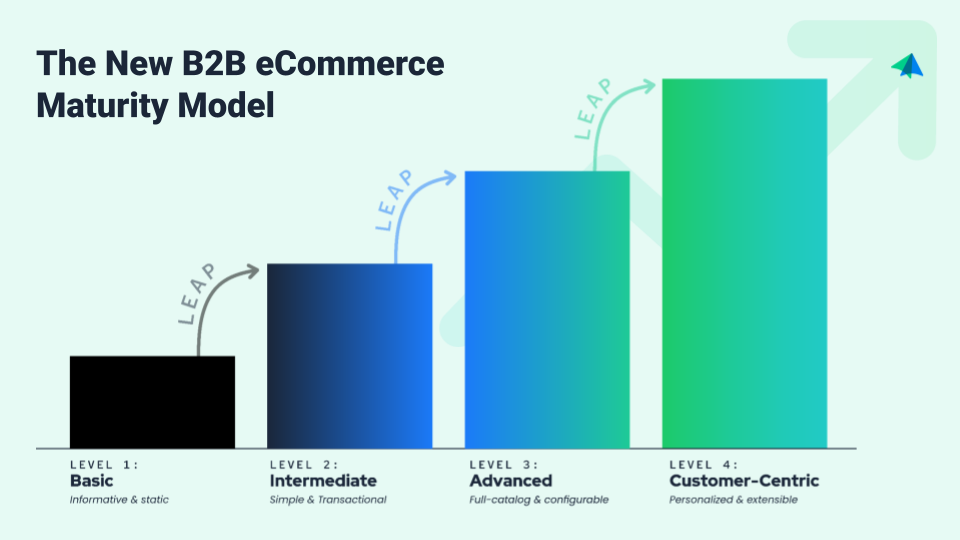B2B companies everywhere are continuing to see staggering growth in eCommerce as not just another viable sales channel, but as a strategic imperative to meet modern buyer expectations and boost revenues in the digital era. But as we know, B2B companies are all at different stages of maturity with their eCommerce. Companies generally fall into one of four levels of the New B2B eCommerce Maturity Model: Basic, Intermediate, Advanced, or Customer-Centric.
This four-part blog series explores each level and provides guidance on how to leap ahead with your eCommerce. This is the third post in the series, which is focused on Level 3: Advanced eCommerce.
Understanding Level 3: Advanced eCommerce
The third stage in our B2B eCommerce maturity model is Level 3: Advanced eCommerce. This level where companies are able to serve up a complete digitized catalog of products and services, while also giving buyers the ability to self-service their entire purchase. But what exactly characterizes Level 3?
The Hallmarks of Advanced eCommerce
Level 3 represents a commitment to increasing eCommerce revenue and delivering on B2B buyers’ expectations. Companies at this stage can offer their full catalog of products and services for buyers to purchase online. In Level 3, the buyer has more control, with opportunities to configure and purchase anything the company sells, regardless of complexity. While this level gives buyers a great degree of autonomy, they typically still need to have a strong grasp of the company’s product offerings as there is no personalization or guided selling enhancing the overall experience.
Key Attributes of Advanced eCommerce
- The company’s full catalog of products and/or services is available to purchase online.
- Buyers are enabled to configure products and orders on their own.
- There is no personalization or guided selling enhancing the experience.
- The eCommerce channel tends to be revenue-supporting vs. revenue-boosting.
- The overall experience is more catalog-centric than customer-centric.
Leaping from Level 3 to Level 4
The journey from Level 3: Advanced eCommerce to Level 4: Customer-Centric eCommerce involves a major leap forward. At Level 4, companies are moving from a more company-focused approach to a buyer-centric — and revenue-boosting — experience. But what does it take to make this leap?
Omnichannel Extensibility
The highest level of B2B eCommerce maturity is ultra-scalable and extensible. By utilizing a headless and composable architecture, you can easily extend to new channels, build and adapt touchpoints with buyers, and scale the experience for whatever tomorrow brings.
Data-Driven Personalization
Level 4 adds personalization into the eCommerce experience, which requires a company to blend product and order data to provide relevant suggestions to buyers along their journey. To do this, you will need robust, clean data as well as intelligent and connective technologies to offer a consistent (and consistently exceptional) experience for your customers.
Smart Product Recommendations and Guided Selling
While Level 3 can support revenue generation by exposing all of your products to buyers online, Level 4 maximizes revenue potential with smart product recommendations and guided selling. Here, your buyer only has to know their own needs and requirements, and your eCommerce experience, powered by a solution like Logik.io, will intelligently serve up perfect-fit products, add-ons, services, and more.
To learn more about Logik.io’s B2B eCommerce Maturity Model and determine your current level and next leap, download our guide today.
Looking for Level 1? Read about Basic eCommerce here.
Looking for Level 2? Read about Intermediate eCommerce here.
Looking for Level 4? Read about Customer-Centric eCommerce here.

